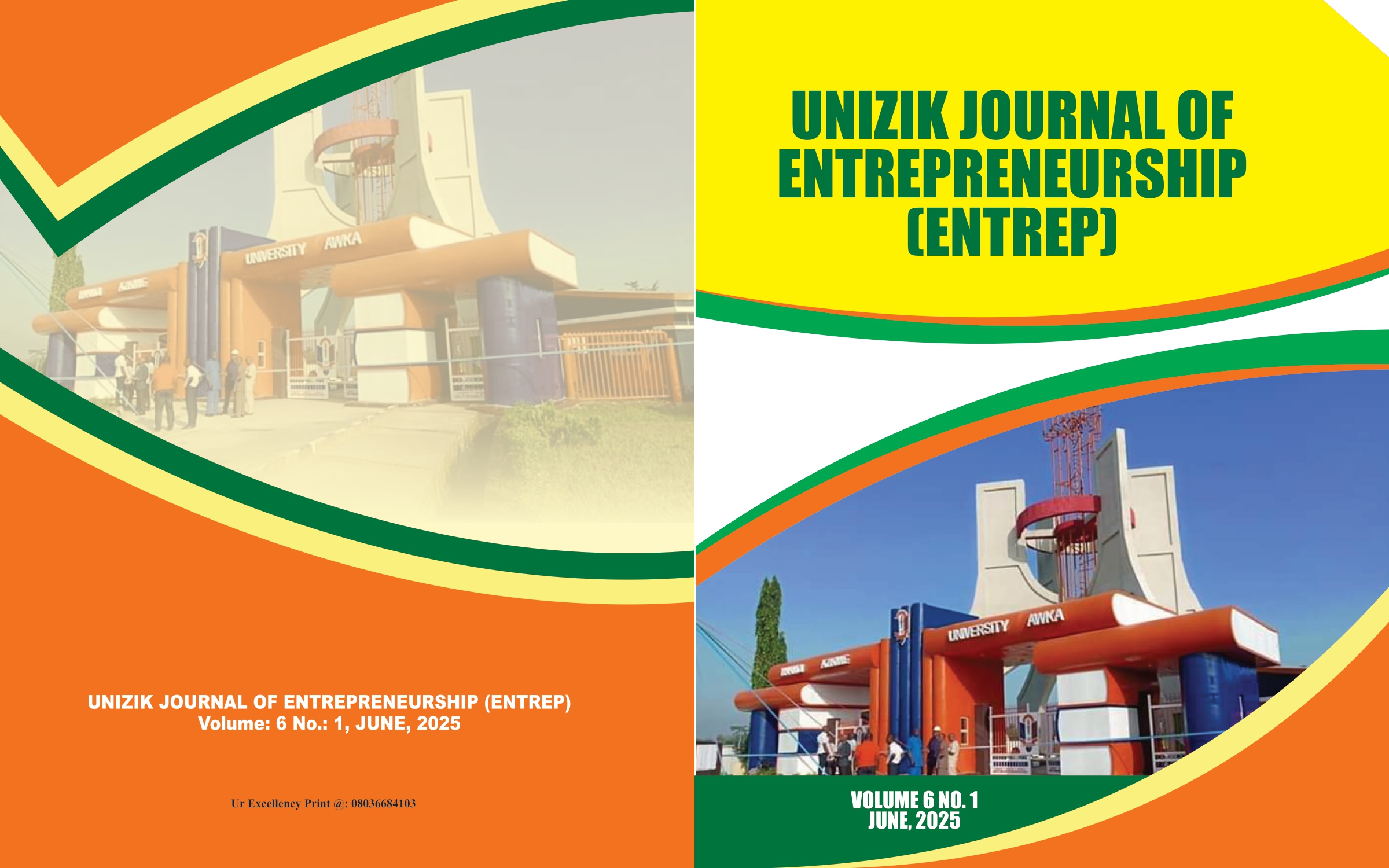EXPORT MARKET AWARENESS AND PARTICIPATION POTENTIALS AMONG RURAL CROP FARMERS IN ABEOKUTA, OGUN STATE
Keywords:
Export awareness, export participation, export potentials, rural farmers, crop farmersAbstract
Nigeria has been making series of efforts to encourage export and improve standard of
living of her most vulnerable people. This study examined the level of awareness in
export market and participation potentials among the rural crop farmers in Abeokuta,
Ogun State. The study employed a mixed-methods design. Quantitative data were
collected from 372 farmers in Ifo block using structured questionnaires, while
qualitative insights were gathered through interviews and focus group discussions.
Stratified random sampling ensured representativeness. Data analysis combined
descriptive statistics with thematic content analysis, enhancing validity and contextual
understanding. The findings indicated that 77% of farmers are aware of export, 79%
have considered export before while about 66.9% are likely to participate in export.
This study concludes that more rural crop farmers are aware of export than those that
are ready to participate in export. The study recommends that export development
institutions should continue with export sensitisation programmes for rural farmers in
order to encourage them to increase their participation in export market while rural crop
farmers should take advantage of the opportunities to export their produce in order to
improve their income and standard of living.
Downloads
References
Abdulai, A., Bahadur, K., & Fraser, E. (2023). What factors influence the likelihood of
rural farmer participation in digital agricultural services? Experience from
smallholder digitalization in Northern Ghana. Outlook on Agriculture, 52(1), 57–66.
https://doi.org/10.1177/00307270221146697
Adesina, A. (2012). Transforming agriculture to grow Nigeria’s economy
[Convocation lecture]. Obafemi Awolowo University, Ile-Ife.
Afreximbank. (2022). Afreximbank, NEPC, and NEXIM Bank sign $1bn agreement to
boost Nigeria’s non-oil exports. https://www.afreximbank.com
Agber, T., Iortima, P. I., & Imbur, E. N. (2013). Lessons from implementation of
Nigeria’s past national agricultural programs for the transformation agenda. American
Journal of Research Communication, 1(10), 238–253.
Ajiye, S. (2014). Achievements of Millennium Development Goals in Nigeria: A
critical examination. International Affairs and Global Strategy, 25, 24–36.
Arokoyo, T. (2012). The concept of participation in agricultural development.
Department of Mass Communication, Zaria.
Busari, A. O., & Wahab, M. K. (2003). Determinants of cashew nuts exports supply in
Nigeria (1980–2020). Scientific Papers Series Management, Economic
Engineering in Agriculture and Rural Development, 23(1), 81–87.
Evbuomwan, G. O., & Okoye, L. U. (2017, July). Evaluating the prospects of the
Anchor Borrowers’ Programme for small scale farmers in Nigeria. Paper
presented at the 21st International Farm Management Congress, Edinburgh, Scotland,
UK.
Ignatius, S. H. M., & Haapasaari, P. E. (2018). Justification theory for the analysis of
the socio- cultural value of fish and fisheries: The case of Baltic salmon. Marine
Policy, 88, 167–173. https://doi.org/10.1016/j.marpol.2017.11.007
Kyaw, N. N., Ahn, S., & Lee, S. H. (2018). Analysis of the factors influencing market
participation among smallholder rice farmers in Magway region, central dry zone of
Myanmar. Sustainability, 10(12), 4441. https://doi.org/10.3390/su10124441
Market Insider. (2015). Nigeria emerging as fruit export giant.
http://www.intracen.org/blog/Nigeria-emerging-as-fruit-export-giant/
Mussema, M., & Dawit, A. (2012). Red pepper marketing in Siltie and Alaba in
SNNPRS of Ethiopia: Factors affecting households' marketed pepper. International
Research Journal of Agricultural Science and Soil Science, 2(6), 261–266.
NAQS. (2020). Plant and plant products import-export requirements.
https://www.naqs.gov.ng/import-export/plant.html
NEPC. (2023). Export development programmes and interventions. Nigerian Export
Promotion Council. https://nepc.gov.ng
Nnoli, T. I., Enilolobo, S. O., Hassan, C. O., & Bello, A. B. (2023). Inflation, exchange
rate and agricultural export in Nigeria. Greener Journal of Agricultural Sciences,
(2), 91–98. https://doi.org/10.5281/zenodo.8114742
Nwanosike, D. U., Kalu, U. I., Ogbuabor, J. E., Uzoechina, B., & Ebenyi, G. O. (2016).
Economic development dynamics in Nigeria: Evidence from 1914–2014. Saudi
Journal of Business and Management Studies, 1(4), 154–161.
Obidike, N. (2011). Rural farmers’ problems accessing agricultural information: A case
study of Nsuka local government area of Enugu State, Nigeria. Library
Philosophy and Practice (e- journal). http://unllib.unl.edu/LPP/
Odetola, T., & Etumnu, C. (2013). Contribution of agriculture to economic growth in
Nigeria. Paper presented at the 18th Annual Conference of the African
Econometric Society, Accra, Ghana. http://www.aaawe.org/wpcontent/uploads/2015/01/Tolulope_paper_mod.pdf
OGADEP. (2017). Extension component report: January–December 2016. Ogun State
Agricultural Development Programme (OGADEP), 30th REFILS Workshop,
Institute of Agricultural Research and Training, Ibadan, Oyo State.
Okon, D. E., & Ukwayi, J. K. (2012). Challenges and prospects of the Millennium
Development Goals (MDGs) in Nigeria. Global Journal of Social Sciences, 11(2),
–132.
Olwande, O., & Mathenge, M. (2012, August). Market participation among poor rural
households in Kenya. Paper presented at the International Association of
Agricultural Economists (IAAE) Triennial Conference, Foz do Iguaçu, Brazil.
Onomu, A. R. (2023). Smallholder’s market participation, characteristics, tractor use
implication and determinants in Nigeria. Journal of Developing Areas, 57(4), 1–27.
https://doi.org/10.1353/jda.2023.a908644
Oseghale, C. (2019). Exploiting Nigeria’s unknown flower, fruit and vegetable export
market. https://shipsandports.com.ng/exploiting-nigerias-unknown-flower-fruitvegetable-export- market/
Otekunrin, O. A., Momoh, S., & Ayinde, I. A. (2022). Investigating food insecurity,
health and environment related factors, and agricultural commercialization in
Southwestern Nigeria: Evidence from smallholder farming households.
Environmental Science and Pollution Research, 29, 51469–51488.
https://doi.org/10.1007/s11356-022-19544-w
Rahman, M. M. (2023). Sample size determination for survey research and nonprobability sampling techniques: A review and set of recommendations. Journal of
Entrepreneurship, Business and Economics, 11(1), 42–62.
Shangshon, B., Wongsamun, C., Polthanee, A., & Suriya, P. (2023). Impact of
agricultural extension services on cereal production among rural farmers in Bhutan.
Journal of Agricultural Extension, 27, 13–26.
Singh, A. S., & Masuku, M. B. (2014). Sampling techniques and determination of
sample size in applied statistics research: An overview. International Journal of
Economics, Commerce and Management, 2(11), 1–22.
Sylvanus, U. F., Edet, I. V., & Ityav, D. L. (2023). Foreign exchange fluctuations on the
performance of agricultural export in Nigeria economy. Asian Journal of
Economics and Empirical Research, 10(1), 10–18.
Yakubu, M., & Akanegbu, B. (2015). Neglecting agriculture and its consequences to
the Nigerian economy: An analytical synthesis. European Journal of Research in
Social Sciences, 3(3), 18–27.
Zheng, H., & Ma, W. (2023). Smartphone-based information acquisition and wheat
farm performance: Insights from a doubly robust IPWRA estimator. Electronic
Commerce Research, 23(2), 633–658. https://doi.org/10.1007/s10660-022-09572-2

